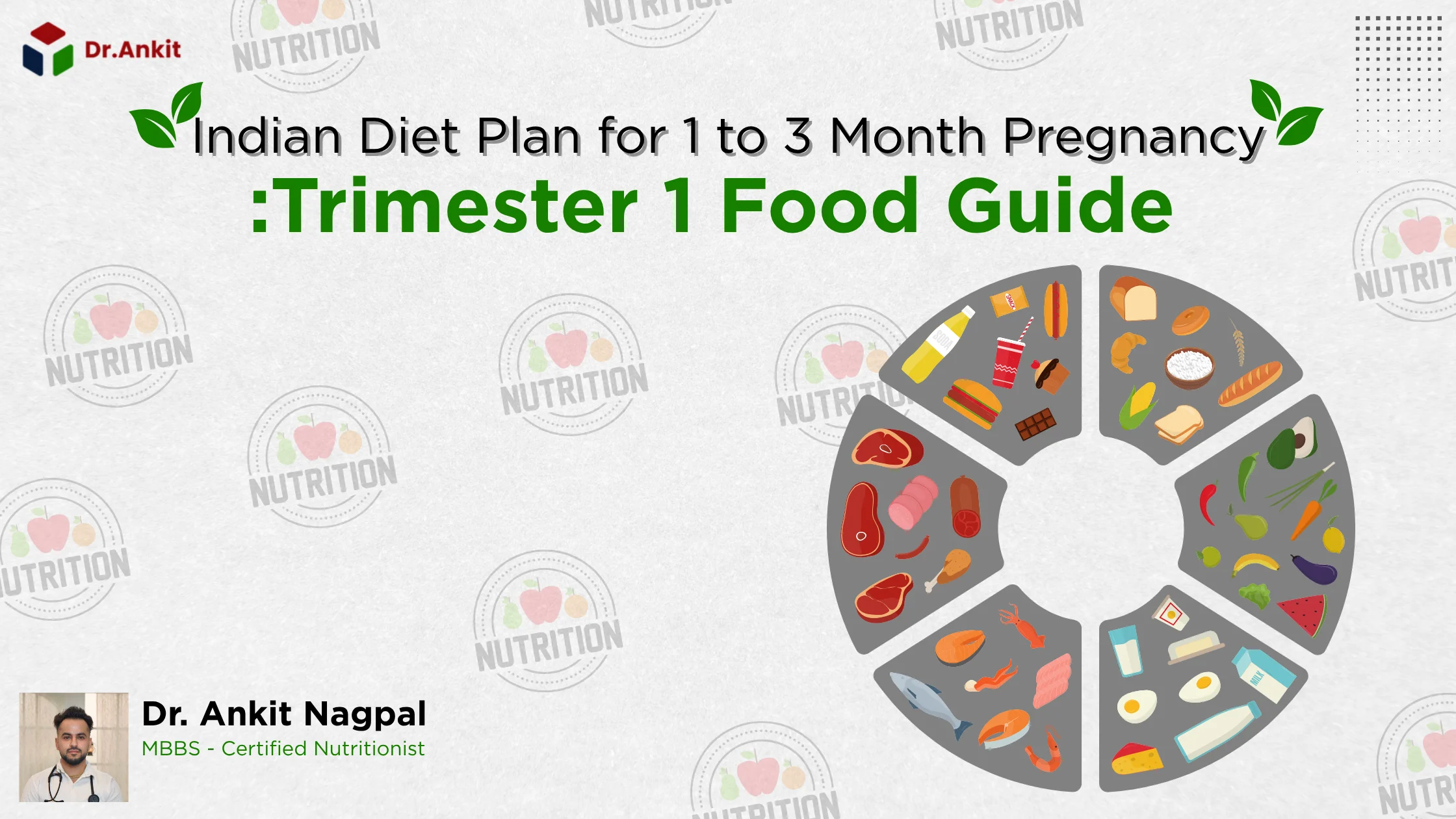Summary
Pregnant First trimester is a magical but a sensitive phase and diet contributes immensely to the successful flow of it. Having the right foods will help to reduce morning sickness, increase energy, and it will help in early development of the baby. In this article, we break down a simple, wholesome Indian diet plan for 1 to 3 month pregnancy, based on Indian kitchen staples. You will receive high-quality advice, food hints, and solutions to frequently asked questions, which are related to the first trimester.
Introduction: Why Does a Healthy First Trimester Diet Matter So Much?
It does all the groundwork for your baby during the first three months of pregnancy to ensure that the baby remains healthy. The organs start developing and the brain, spine and the heart are actually starting to develop in week 6. Your nutrition at this stage does not only imply the performance of your child, but it also determines your own everyday well being. Hi i am Dr. Ankit Nagpal certified nutritionist and i will provide you a good 1 to 3 month pregnancy diet chart Indian style can help you manage nausea, stay energized, and avoid nutritional gaps from the start.
What Should a 1 to 3 Month Pregnancy Diet Chart Indian Style Include?
Being the best dietitian in Ludhiana i usually guide that First trimester Indian pregnancy diet must be balanced, comfortable, and nutrient fortified. Due to the common occurrence of morning sickness and food aversions, it is recommended that the meals are light and frequent. Avoid greasy, too-spicy food and the preference of ingredients, which are easy to digest, though still keeping them rich in nutrients are the aim. Think dal, rice, lightly spiced sabzi, curd, and seasonal fruits.
Prioritize Easily Digestible Meals
Such food as khichdi, sabudana, idli and moong dal are ideal. Not only are they easy on the stomach but also a good source of nutrition hence suited to nausea-ridden mornings.
Eat Small, Balanced Portions Every Few Hours
Eat five or six meals a day instead of three huge ones. This maintains the blood sugar and decreases fatigue and improves digestion at any hour.
What Are the Key Nutrients to Focus on in the First Trimester?
Your baby is growing so fast hence you are required to nourish your body with the correct nutrients. They are not some buzz words, they are essential components of placenta, spinal cord, bones, and brain building blocks. A balanced 1 to 3 month pregnancy diet chart Indian approach includes everything from folic acid to protein, delivered through familiar Indian foods. Being aware of what it should contain, it may be much easier to plan the meal.
Load Up on Folic Acid, Iron, and Calcium
Folic acid is taken in the form of spinach, black chana and oranges. In the case of iron, use dates, jaggery and poha. The crucial boost to your baby bone formation is found in calcium which is found in Ragi, sesame seeds and dairy products.
Don’t Forget Protein, Fiber, and Omega-3
Dairy products such as paneer and milk as well as lentils are good sources of protein among vegetarians. Add flaxseeds, chia seeds and walnuts- these are omega 3. And fruits and whole grain fiber keep the digestion running smoothly and reduce constipation.
What Does a Typical Indian Diet Plan Look Like for 1 to 3 Month Pregnancy?
You do not need to change the dinner preserve on your diet regime–you can make small adjustments to it. A traditional Indian diet already has plenty of nutritious foods; one simply needs to coordinate it, to match the right foods at the right time. Here’s a sample 1 to 3 month pregnancy diet chart Indian style that’s easy to follow and flexible based on your taste or region.
Sample Daily Meal Schedule
- Breakfast: Ragi porridge or multigrain paratha with curd
- Mid-Morning: Coconut water, banana, or boiled eggs
- Lunch: Rice or roti with dal, sabzi, and fresh salad
- Snack: Roasted chana, makhana, or fresh fruit
- Dinner: Khichdi or light pulao with palak paneer and curd
Weekly Ideas to Rotate
Make it interesting by including sattu drink, upma of vegetables, moong dal chilla and curd rice. Make adjustments in case you are feeling queasy ditto with flavoring leaving less oil in addition to less spices and more steamed or boiled dishes are the usual rally there.
Which Indian Foods Should Be Avoided During the First Trimester?
Some common ingredients can be very delicious but they are not the best in the first trimester. They may result in indigestion or force the uterus to have contractions or they may even add an unneeded risk when your body is still adapting. Beware is not removing it all, it is simply avoiding dangerous, strong choices instead having safe and moderated choices.
Foods to Limit or Skip Altogether
Raw papaya, pineapple, and unpasteurized milk are some of the foods to avoid. One should also avoid highly fried snacks and street foods and excessively spicy pickles because they are likely to bloat or give one acidity.
Keep Caffeine Low and Watch for Overeating
Have no more than one cup of tea and coffee a day. But even though cravings are real, make an effort not to overeat, it is about quality, quantity, especially during the first three months.
How to Stay Nourished When You Feel Sick All the Time?
The first trimester is not easy: lets face it. The sick feelings and feeling tired, combined with aversions to things that smell can make eating a challenge, much less something which is said to be healthy. However, one can get nutrition in a soft manner. It is all about identifying the little triumphs with the food you can be comfortable and energized.
Try Light, Neutral Flavors
Plain foods such as simple curd rice, boiled potatoes and a little lemon juice or even ginger tea can soothe nausea. One should not eat spicy or oily foods, more so at nighttime.
Focus on Hydration and Small Snacks
It can be that all you can do sometimes is having coconut water or sucking on lemon candy and that is okay. Snacks such as fruit, sabudana, or dry toast will make you eat something in between meals.
Frequently Asked Questions (FAQs)
Q1: Can I eat eggs during the first trimester of pregnancy?
Yes, provided they are done thoroughly. Eggs contain lots of protein, and vitamin D and B12 that are vitally important in the development of your baby.
Q2: What fruits are safe to eat during 1 to 3 month pregnancy in India?
Banana, apple, pomegranate, oranges, guava and sweet lime are very good ones. And one thing is, clean them well, and eat them green.
Q3: Is a vegetarian Indian diet enough in the first trimester?
Absolutely. The diet that can easily support your needs is a well-balanced vegetarian diet that is composed of dal, dairy, nuts, seeds and leafy greens.
Q4: How often should I eat during the first trimester?
Eat 5–6 tiny meals a day. It eliminates nausea, stabilizes blood sugar and maintains your energy.
Final Thoughts
OK that’s all for today, me signing off now. Following an Indian diet plan for 1 to 3 month pregnancy doesn’t need to be complicated or expensive. By spending a few minutes of planning and keeping this in mind, your daily diet can indeed be much more than adequate to foster the growth of your baby and your health. Avoid processed, foreign and out of season foods. What works is to stay mindful of your body, eat when you feel hungry, and do not become worried about perfection in eating every day. Everything in your first trimester should be balanced, between what you want or crave, what you would feel comfortable eating and what is healthy nutrition. This should be easy.


